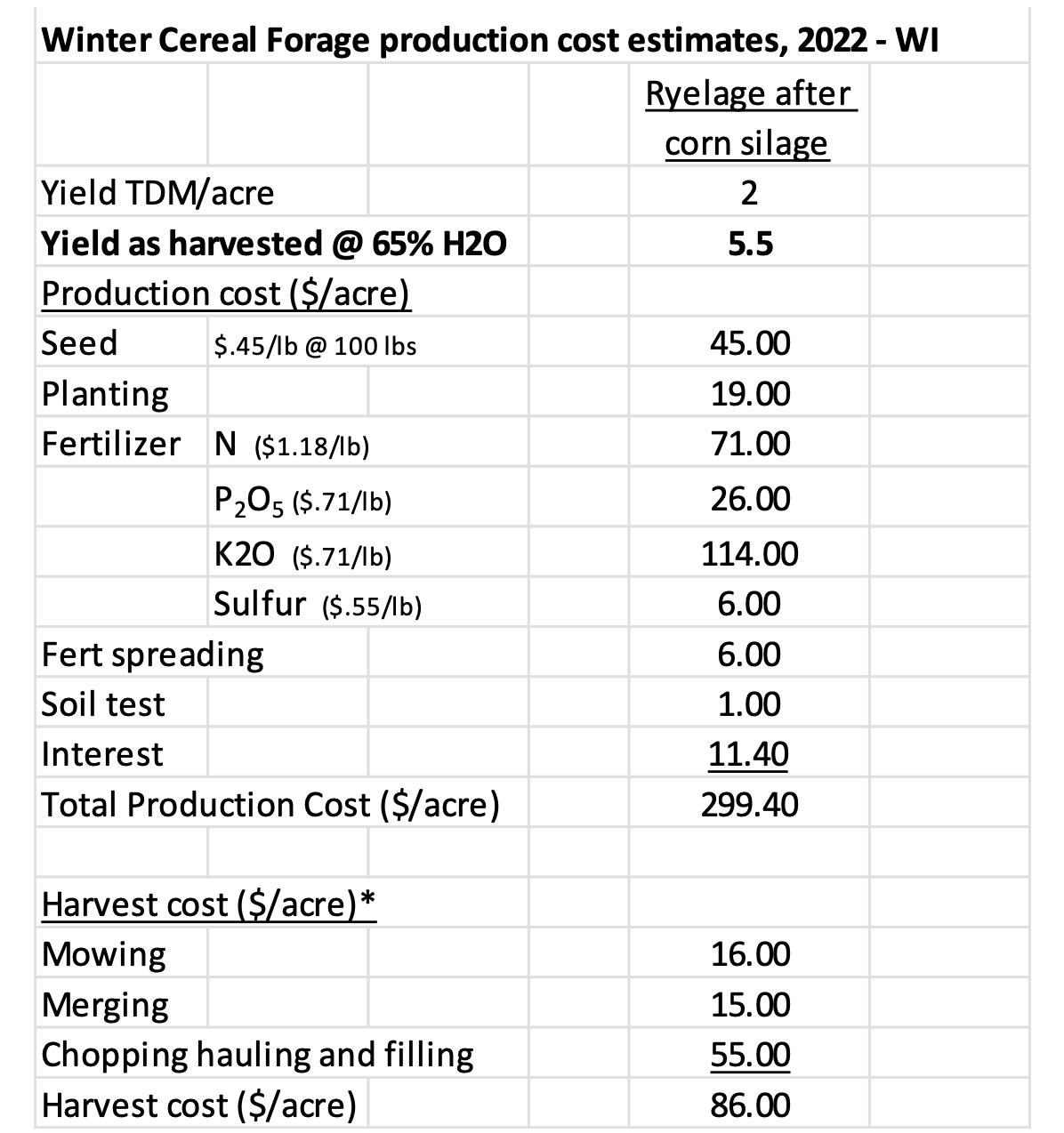By Kevin Shelley
Winter Cereal Forage Cost of production (per-acre and per-ton)
When determining a fair price for standing or harvested winter cereal rye or triticale forages, the first step is to determine the cost of production so that a “break even” estimate can be made. The following cost of production estimate is based on retail fertilizer and seed prices collected in southern, WI in early 2022, and published 2022 custom rates for field operations by Iowa State Extension. https://www.extension.iastate.edu/agdm/crops/pdf/a3-10.pdf. Fertilizer costs are based on N-rate application guidelines and estimated P2O5 and K2O removal at an assumed forage yield of 1.9 tons of dry matter (TDM) per-acre (UWEX A2809).

In this example, if the forage is to be sold standing (unharvested), the seller will need to receive $299 per-acre just to cover the cost of production (at this yield level). This equates to $54 per ton of forage, as harvested. Additional funds would need to be received to cover land and management costs or desired profit. This example also assumes the forage was planted no-till. If the seller performs the harvest, those costs will need to be covered as well. Here, we are estimating an additional $86 per-acre for complete harvest and storage filling (total = $69.63 per ton as harvested).
Determining a price per-acre based on forage harvested
Measure yield by weighing a representative load and counting the total number of loads harvested. Portable weigh pads may be available at your County conservation or Extension offices, or here at the NPM program. Or, take a drive to a nearby scale (full and empty). Storage structure or silage bag measurements can also be used to estimate forage harvested from known acres. Collect several samples of the fresh chopped forage from various loads and combine for a composite sample from each field. Freeze those samples immediately for later submission to a forage analysis lab to obtain dry matter content and forage quality measures, including relative forage quality (RFQ). The forage value, per-acre, will be based on forage yield and RFQ.
There are various methods for calculating the value of any forage based on quality parameters and performance metrics such as milk per-ton of dry matter. However, the most straight forward method for buyers and sellers is to use current market prices for hay. Updated Hay Market Demand and Price Reports for the Upper Midwest can be found at https://cropsandsoils.extension.wisc.edu/hay-market-report/. Average prices, and price ranges, for different size bales of dry hay are reported on an as-fed moisture basis for quality grades using RFQ. To convert tons harvested from your field to a dry hay equivalent for calculating a per-acre price, use the following formula:
Hay Yield = (Harvested silage yield X % Dry Matter)/.85*
* Assumed dry matter content of dry hay
As an example, data collected in UW-NPM research trials and from on-farm forage sampling suggests yields approximating 5.5 tons at 35% dry matter with an RFQ of 103-124 (Grade 2) are attainable. The above formula would suggest a dry hay yield equivalent of 2.26 tons per-acre. The May 9, 2022 Hay Market Demand and Price Report suggests an average price of $150 per-ton, as fed, for grade 2 dry hay (large round and square bales). Therefore, a per-acre price of $339 could be estimated prior to harvest (2.26 tons X $150 per-ton), with the actual pricing based on actual yield and quality realized. This price, based on current commercial markets for hay, would apply to harvested hay forage. Therefore, if the purchaser is doing the harvest, estimated harvest, hauling and filling costs would likely be deducted. In this example, $339 (per acre forage value) – $86 (harvest costs) = $253 per-acre net per-acre price. Unfortunately, this value is less than the estimated cost of production of $299.40. This scenario is not unlikely in our current environment of high fertilizer/crop nutrient costs and increased harvest costs. Harvest costs are often relatively high relative to these somewhat low yielding, medium quality forages.
Factors to consider: Price should be based on covering the cost of production to the seller. Quality will be based on timing of harvest relative to the “boot” or early heading stages of growth and favorable weather for chopping. Higher quality will assume a higher value per-ton. There may be some quality risk assumed by the purchaser if they are doing the harvest. Higher yields will remove additional nutrients. Cash costs of production may be lower if manure is a source of nutrients and is plentiful on the farm. A local source of rye or triticale forage may garner a higher value for a purchaser if forage inventories are low. Cereal forages can provide a good nutritional niche for some cattle groups such as dairy heifers. There may be a hauling cost advantage to local forage compared to the distance to hay markets.
Source : wisc.edu